
| What is Flavor and Fortune? |
| How do I subscribe? |
| How do I get past issues? |
| How do I advertise? |
| How do I contact the editor? |
Read 12884663 times
Connect me to:
| Home |
| Articles |
| Book reviews |
| Letters to the Editor |
| Newmans News and Notes |
| Recipes |
| Restaurant reviews |
| Article Index (all years, slow) |
| List of Article Years |
| Article Index (2025) |
| Article Index (last 2 years) |
| Things others say |
| Related Links |
| Log In... |
| Authors |
| Categories & Topics |
TOPICS INCLUDE: Noodles; China's elderly; Home-cooked sauces; Eating camel; Wormwood; Pigs in China; Tofu fish cake; Duanwu Festival; Stuffed crullers; Beech mushrooms; Galia melon; Kaifeng; Tibetan butter churn
| by Jacqueline M. Newman |
Letters to the Editor
Spring Volume: 2012 Issue: 19(1) page(s): 8 - 10 and 19
Stimulated by Recipe Requests in Volume 18(4), for those who asked, we suggest Gary Hou's Asian Noodles, but this a costly volume published by John Wiley & Sons in Hoboken NJ in 2010; its ISBN is 978-0-470-17922-2; it sells for $195.00. It does do a fine job detailing the science, technology, and processing, but has little about the culinary and certainly not how to cook any noodle variety. It includes wheat breeding in China and the United States, milling in Japan and Taiwan, instant noodle seasonings, packaging, pilot plants, objective and sensory evaluation, and more. For cooking noodles, check two books previously reviewed, Asian Noodles in 1997's Volume 4(2), and Easy Asian Noodles in 2010's Volume 17(3). Also look at most general Chinese cookbooks as they usually have a chapter with noodle recipes and another with dim sum or snacks, check chapter titles as many snack foods use rolled or pinched dough; and do look at Florence Lin's Complete Book of Noodles, Dim Sum, and Breads, Lee Hwa Lin's Noodles: Classical Chinese Cooking and her Noodles: Chinese Home Cooking, and Nina Simonds' Asian Noodles, and Jacki Passmore's Noodle Shop Cookbook. These should help answer questions and cook up many great noodle dishes.
From IAN in LONDON UK via e-mail:
America has a huge population of seniors. If what I read is correct, there are now many senior citizen residences in China. When I was there for two years, ten years ago, I never saw one. Who plans their meals and what do they eat?
IAN: China has a growing elderly population, their life expectancy is now 75.5 for females, 71.6 for males, compared to 80.7 and 75.7 years, respectively, in the United States. China Today reports thirty-eight thousand homes for these folks and three main types of facilities. There are those run by the government, private ones, and some straddling these two types of ownership. As to the foods they serve, we found no way to assess that, and from the few we visited, there is no simple answer. The foods we saw and inquired about were uneven in quantity and quality, different in preparation, presentation, and no one working there could or would answer your question.
From RICK via e-mail:
What is Thai basil and how does it differ from the basil served in Chinese restaurants?
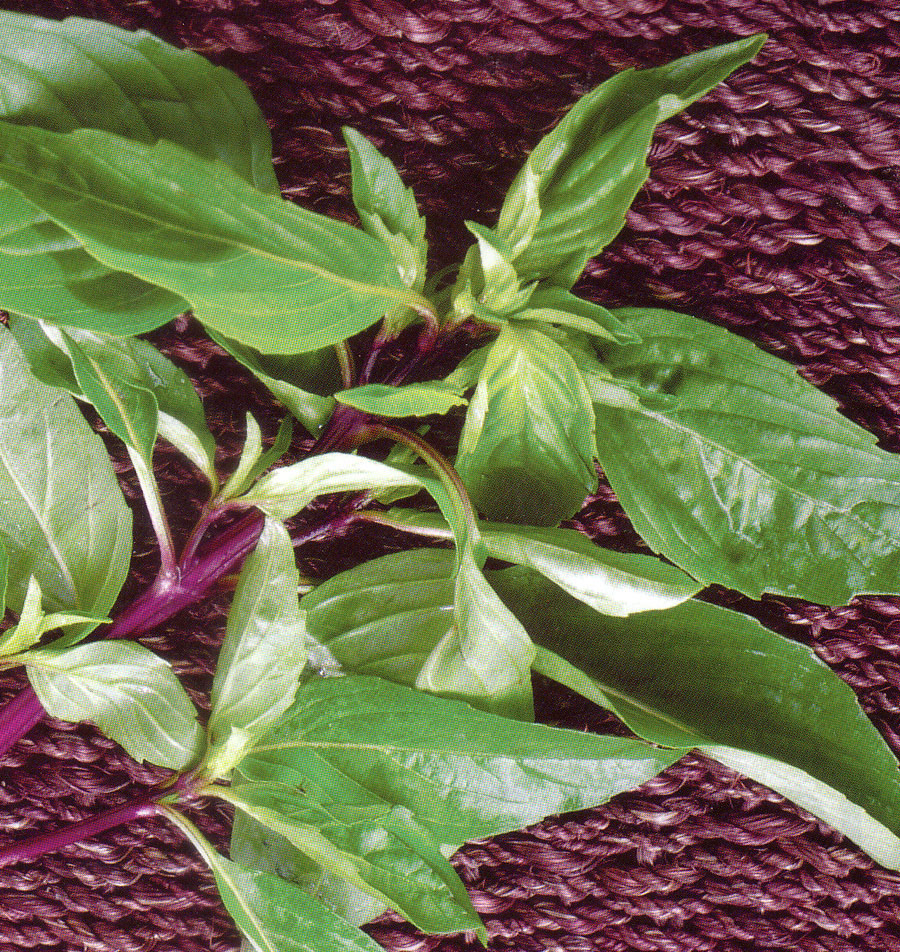 RICK: Known simply as basil or as sweet basil, even Asian basil, botanically the variety I think you are referring to is either Ocimum basilicum or Ocimum sanctum. There are quite a few Origanum varieties including those you may know as marjoram, oregano, or basil. In these three major groups are many different cultivars, and in China, the purple or Tulsi is often Ocimum sanctum and called purple basil. The stems have a purplish tint and a more clove-like taste, the under-side of their leaves can be quite purple. They are sweeter than common basil, botanically the former kind, and some say they become purple when grown in strong sun and hot temperatures. They have pointed leaves and leave them on the stems so they maintain their taste potency. No matter what a recipe says, we suggest adding them just before serving the dish you plan to add them to. Part of the picture we showed in the had copy is from the April 2009 issue of Asian Restaurant News. We include it because it is the best photograph of this basil variety, even better than the dozen we took.
RICK: Known simply as basil or as sweet basil, even Asian basil, botanically the variety I think you are referring to is either Ocimum basilicum or Ocimum sanctum. There are quite a few Origanum varieties including those you may know as marjoram, oregano, or basil. In these three major groups are many different cultivars, and in China, the purple or Tulsi is often Ocimum sanctum and called purple basil. The stems have a purplish tint and a more clove-like taste, the under-side of their leaves can be quite purple. They are sweeter than common basil, botanically the former kind, and some say they become purple when grown in strong sun and hot temperatures. They have pointed leaves and leave them on the stems so they maintain their taste potency. No matter what a recipe says, we suggest adding them just before serving the dish you plan to add them to. Part of the picture we showed in the had copy is from the April 2009 issue of Asian Restaurant News. We include it because it is the best photograph of this basil variety, even better than the dozen we took.
From MARY in NEW YORK, via e-mail:
Can you tell us something about Chinatowns in the five boroughs of New York City?
MARY: Chinatown in Manhattan is one of the oldest neighborhoods in New York City no matter the ethnicity of its residents. It is where the Chinese living in this city first settled and that was the mid to late 1800s. About ten years ago, this Chinatown had the city's largest Chinese population; but that is no longer true. Flushing, in the borough of Queens, and Sunset Park, in the borough of Brooklyn, now have larger Chinese populations. Homecrest in the Bronx and Staten Island, the latter officially known as the borough of Richmond, have no concentrations of Chinese, nor do they have large Chinese markets we could locate.
From DELLY via e-mail:
Think you once mentioned eating camel toe, or maybe it was camel hump. I am surprised and do wonder where in China one can eat any part of a camel. Advice will be appreciated.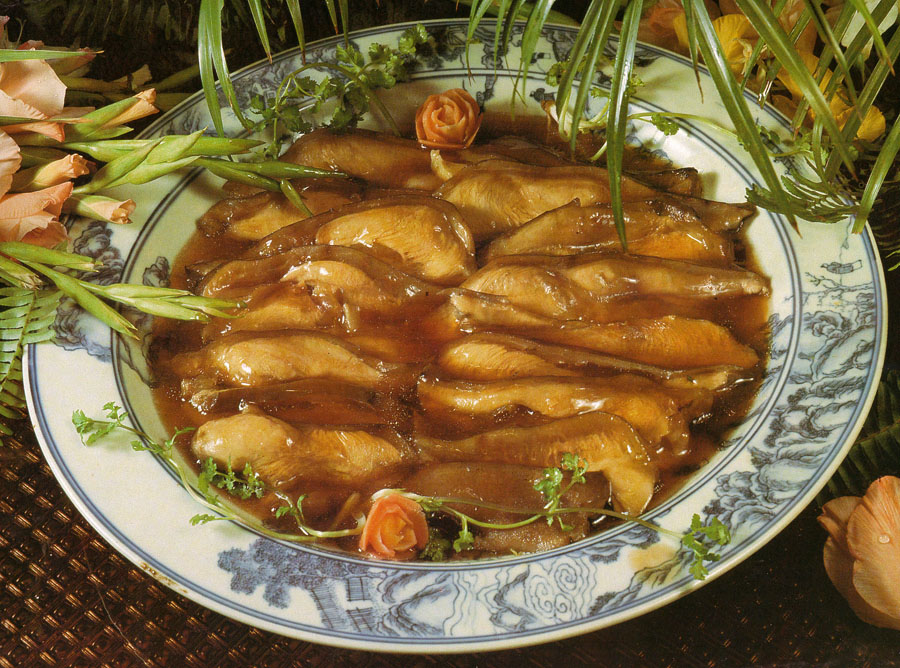 DELLY: Some years ago, I did have camel, the part served was called 'Camel Toe.' It was in or near Xian. As to a restaurant now serving it, I do not know if it is legal to butcher and serve these animals. I assume you know that camels were used for transportation, and for food if one died along the so-called silk route. It may still be available in the Gansu and Juangsu Provinces, it has been written about in both, and recipes do exist for camel hump. One called 'Camel Hump Fried with Five Slices,' it is made with bamboo shoots, chicken, chives, ham, mushrooms, and other ingredients. It was served with or on noodles, and it indicates it a fifteen hundred year old delicacy. In a tri-lingual book, Delicacies of Jiangsu Style, there is a recipe for Braised Camel Hoofs. Should you have access to one of these items, they say it is similar to bear paw, touted as golden in color, tender to eat, but needing to get rid of its strong smell. If you get to see or make any, please tell us about it. For those who may have access and want to prepare it, here is a picture of the dish, its recipe copied from that book. Do note they include 'clear soup' but do not list it as an ingredient.
DELLY: Some years ago, I did have camel, the part served was called 'Camel Toe.' It was in or near Xian. As to a restaurant now serving it, I do not know if it is legal to butcher and serve these animals. I assume you know that camels were used for transportation, and for food if one died along the so-called silk route. It may still be available in the Gansu and Juangsu Provinces, it has been written about in both, and recipes do exist for camel hump. One called 'Camel Hump Fried with Five Slices,' it is made with bamboo shoots, chicken, chives, ham, mushrooms, and other ingredients. It was served with or on noodles, and it indicates it a fifteen hundred year old delicacy. In a tri-lingual book, Delicacies of Jiangsu Style, there is a recipe for Braised Camel Hoofs. Should you have access to one of these items, they say it is similar to bear paw, touted as golden in color, tender to eat, but needing to get rid of its strong smell. If you get to see or make any, please tell us about it. For those who may have access and want to prepare it, here is a picture of the dish, its recipe copied from that book. Do note they include 'clear soup' but do not list it as an ingredient.
From RHODA in Palm Springs CA:
You did not mention wormwood's use in malaria. Why not? Is that still used for that purpose, I was once given some for a serious case of it?
RHODA: You are correct, and that was an oversight. There is a rather new Chinese drug called qing hao su which means 'sweet wormwood essence.' Best we could learn, this drug is made with lots of wormwood along with other things, and has been in use about ten or fifteen years. The major basis for the drug is sweet wormwood or Artemesia annual. It was an important find because the quinine most used was meeting resistance from many malarial parasites. This new drug, developed by testing many Chinese folk remedies, including some found in ancient Chinese literature, seems to have had its origin in Ge Hong written in the Jin Dynasty (317 - 420 CE). Thank you for calling our attention to it.
From JULIA in London:
Love your magazine and do appreciate many of your statistics. Any idea how many pigs the Chinese eat in a year?
JULIA: Could not find an answer to your question, but did learn that one and one-third billion pigs are slaughtered world-wide for food each year, as are fifty-two billion chickens, five and a quarter million sheep, two and a half billion ducks, and three million cows. Recently, the Chinese government said it plans to release two hundred twenty tons of stashed frozen pork, but did not say how many pigs that is nor how many are already in the marketplace. Chinese pigs, when slaughtered, are smaller than those in the United States, and they probably weight lots less than five hundred pounds. What they did advise is that pork makes up more than half the meat consumed in China, in some areas it is seventy percent.
From AMAN via e-mail:
Just returned from Southern China including Shanghai and in a restaurant, ate a dish called Tofu Fish Cake with Black Beans. The cake was square and made of what I think the waiter said are fish cakes with lots of garlic and lots of black beans. However, the texture was more firm that either tofu or fish and I saw no black beans. Any idea what I was eating. If so, any idea how to make these tofu fish cakes? Another question; at another table, saw someone reading: a book called Discover Shanghai. Can you locate the book and tell about it?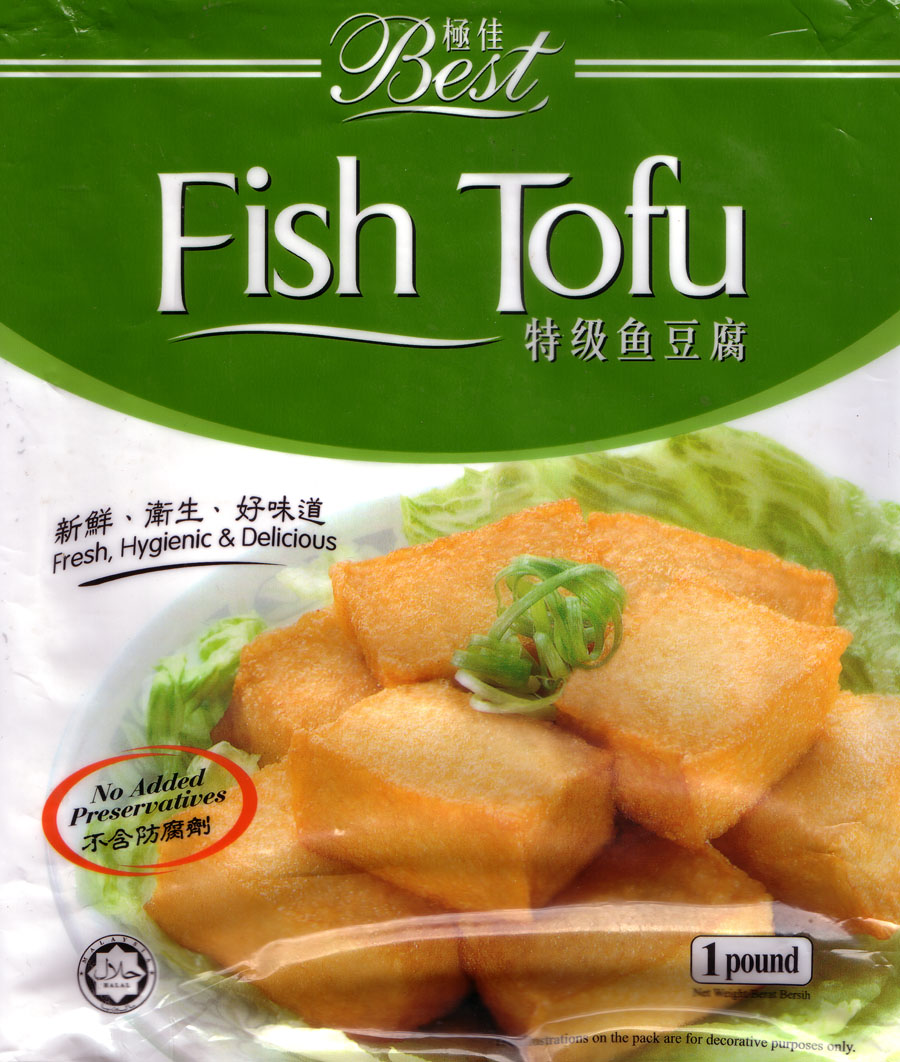 AMAN: To the first question, only half an answer. To the second, the book: Discover Shanghai is by Eric N. Danielson and published by Marshall Cavendish International of Singapore in 2010. This excellent tour guide of popular and lesser known places, has color photographs, historical background, fine details, and what every tourist should carry when going there. However, it does have one drawback, no index.
AMAN: To the first question, only half an answer. To the second, the book: Discover Shanghai is by Eric N. Danielson and published by Marshall Cavendish International of Singapore in 2010. This excellent tour guide of popular and lesser known places, has color photographs, historical background, fine details, and what every tourist should carry when going there. However, it does have one drawback, no index.
As to your first question, went to the web, to large Asian markets, and spoke to several friends but only one chap in one market cold help. He took my hand and led me to the freezer and showed me a stack of flat green plastic bags indicating they were packaged by Best Int''''l Trading Inc. and imported from Malaysia. I did buy some even though their ''''expiry'''' date was a year before. Thought better of that foolishness, and at home did throw them out. Recently, I found them again, eight months before their expiration date. I did try calling the company in Los Angeles, left messages but no one returned my call. Incidentally, their web site says breaded ones are from Thailand and for vegetarians. My package ingredient list says: Fish meat, starch, sugar, salt, vegetable oil, and seasonings; and it shows that one can stir-fry, steam, barbecue, and microwave them. It also says one hundred grams of this product has one hundred eighty calories. When opened, I found thirty attached frozen cubes and did stir-fry some, steam others, deep-fried still others, and left some frozen. They were just OK. Two weeks later, I found a recipe for them in a cookbook. I made that then designed a better one; it is at the end of this column.
From ALLEN in MONTICELLO NY:
What is the Duanwu Festival the Han Chinese celebrate?
ALLEN: You may know this as the Dragon Boat Festival, dedicated to poet Qu Yuan (340 - 278 BCE) who was exiled to Hunan because he was a political dissident. Showing loyalty to the state and his monarch, he threw himself in the Milou River and drowned. Locals rowed out and dropped rice balls to feed the fish so they would not nibble on him. During this holiday to celebrate this fellow, Han Chinese celebrate with dragon boat races, eat zongzi, hang mugwort on their doors, and drink a special wine. In 2009, China applied to UNESCO for inclusion of this festival in the World Intangible Cultural Heritage list. Check this website's recipe lists, there are several recipes for zongzi.
From EDDIE-LYNN in MANHATTAN:
We had a delicious long dough stuffed with cuttlefish; any chance you can locate a recipe for same?
EDDIE-LYNN: Seen more recipes stuffing these long twisted deep-fried crullers with shrimp than with cuttlefish. What one stuffs them with can vary, and we challenge you to invent and enjoy them many different ways. At the ned of this column is one we dreamed up.
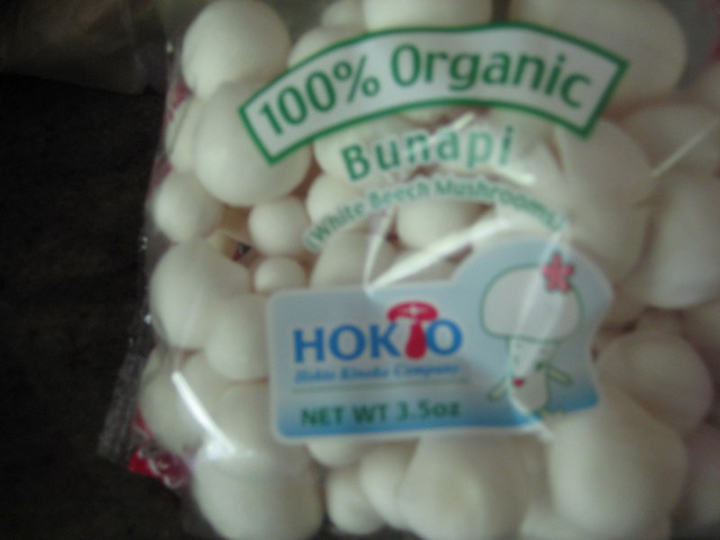 From HANI in BROOKLYN:
From HANI in BROOKLYN:
You wrote about the beech mushroom, recently we had them with ostrich meat, minced and marvelous. Can you help us locate a recipe for them?
HANI: Popular in Hong Kong and Taiwan, Below is one a friend suggested. Hope you find them as marvelous as she did.
From PETER via e-mail:
In the last issue on page 37, you refer to galia melon. What kind of melon is that?
PETER: Developed in Israel in 1970, this melon is now grown in at least a half dozen countries, the United States included. Do look for it in your supermarket. The melon is a cross between a honeydew melon and a cantaloupe; and it is quite delicious.
From SUE via e-mail:
Why did I see Kaifeng written with four characters when there are only two syllables in that city's name; and when do you plan to write something about this once capital city of China and its foods?
SUE: To answer these questions in a single sentence as was your query, the first two are the name of this city in simplified characters, the last two are the older and more traditional way it was written, and I suggest you and others read about it in the next issue.
TO ALL who asked for a picture of a Tibetan butter churn, check these out.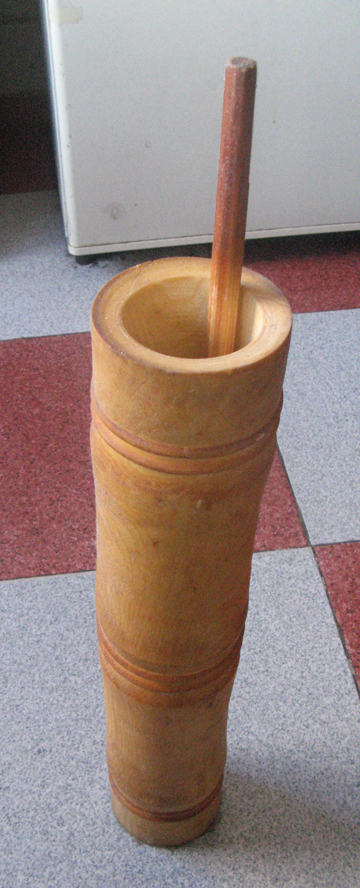
 The two are the same butter churn, one without its cover on the left, one with its cover on the right. Sorry it took so long to find someone who had one; and we do offer him thanks.
The two are the same butter churn, one without its cover on the left, one with its cover on the right. Sorry it took so long to find someone who had one; and we do offer him thanks.
| Braised Camel Hoofs |
|---|
One camel hoof Other materials: 1.5 kg chicken, 500 g spareribs,10 hearts of green vegetables Condiments: 15 g soy sauce, 3 g salt, 20 g Shaoxing wine, a little sugar, 25 g shallots and ginger, a little pepper ash, 75 g vegetable oil Cooking method: 1. Soak the camel hoof in cold water, and thoroughly clean it. Simmer the camel hoof thoroughly, rub off the black membrane, soak in water again. Get rid of the smell with shallots and ginger and Shaoxing wine. 2. Put camel hoof, chicken and spareribs in a pot, boil thoroughly. 3. Put the wok over heat, pour in some oil, then the clear soup, and then the camel hoof. Add condiments to it. Braise for a while, then move the wok to high heat, then dish out. Edge the plate with vegetable hearts. |
| Tofu Fish Cake and Wintermelon |
|---|
2 pounds wintermelon, peeled and cut into cubes the size of the fish tofu cubes 1 pound frozen tofu fish cubes 2 Tablespoons vegetable oil, separated 2 cups chicken stock 1/2 teaspoon salt 1 Tablespoon black bean sauce Preparation: 1. Blanch frozen tofu fish cakes in boiling water for two minutes, then drain for five minutes. 2. Heat wok or fry pan, add one tablespoon oil and pan fry the tofu fish cakes until lightly charred and no longer sizzling (about four minutes). Remove and set side. 3. Add rest of the oil and stir-fry the wintermelon pieces until lightly charred, about three minutes, then add the chicken stock, salt, and black beans, cover, and allow to boil. Stirring every two to three minutes. If it boils dry, add half cup of water, and let boil for ten minutes in total, then turn off the heat and let rest for five minutes before putting in a bowl and serving this dish. |
| Stuffed Deep-fried Crullers |
|---|
1 pair deep-fried ten- to twelve-inch crullers, each cut in four sections 1 cup minced cuttlefish 1 Tablespoon sa cha sauce 2 Tablespoons cornstarch 3 Tablespoons sesame seeds 2 cups vegetable oil 1/4 cup plum sauce Preparation: 1. Push a chopstick through each section of the cruller. 2. Mix cuttlefish with the sa cha sauce and stuff some into each section, dipping its ends into the cornstarch. Sprinkle some water on the outside of the cruller, just to dampen, then sprinkle the sesame seeds on it. 3. In a large pot, heat the oil, then deep fry the crullers, preferably in two batches, until crisp. 4. Drain on paper towels, then serve while hot or very warm with the plum sauce on the side for those who want to dip them. |
| Beech Mushrooms and Meat |
|---|
1/4 pound ostrich (or another red meat), chopped 1 teaspoon dark soy sauce 1 teaspoon sugar 1 teaspoon chicken bouillon powder 3 ounces beech mushrooms, rinsed, then coarsely minced 3 Tablespoons cornstarch mixed with two tablespoons cold water 3 sprigs fresh coriander, minced 1 Tablespoon fresh ginger, minced 2 egg whites 1/2 teaspoon sesame oil Preparation: 1. Mix ostrich, soy sauce, sugar, and bouillon powder and set aside for half an hour. 2. Bring two cups water to the boil, add meat and mushrooms and as soon as water returns to the boil, turn off the heat source and stir in cornstarch mixture and stirring it until thickened. 3. Remove pot from the heat source, stir in minced coriander and fresh ginger and the egg whites and stir for one minute. Then add sesame oil and serve. |

Copyright © 1994-2025 by ISACC, all rights reserved
Address
3 Jefferson Ferry Drive
S. Setauket NY 11720